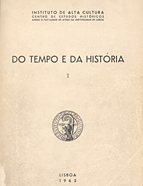

................................
The journal Do Tempo e da História featured contributions from two categories of authors: established national and international researchers and young graduates fresh out of university. Among the regular contributors, Virgínia Rau stood out for her frequent participation. Other noteworthy Portuguese researchers who published notable articles included Avelino Teixeira da Mota, Eduardo Borges Nunes, Iria Gonçalves, Isaías da Rosa Pereira, Jorge Borges de Macedo, José Mattoso, Manuel Henrique Côrte-Real, Maria Adelaide Salvador Marques, Maria José Lagos Trindade, Maria José Pimenta Ferro, Maria Olímpia da Rocha Gil, Maria Teresa Trigo Neto e Cova, and Martim de Albuquerque. From an international perspective, contributions by Carmelo Trasselli, Frédéric Mauro, Henri Lapeyre, Hermann Kellenbenz, and Peter E. Russell were particularly prominent.
An analysis of the articles reveals two dominant historical periods: the mediaeval and modern eras, with contemporary history being notably scarce. This same trend is observed in the most important university history journal of the time, the Revista Portuguesa de História [Portuguese Journal of History] (founded in 1941). The near-absence of articles focused on contemporary history may be explained by the "scientific fear" of studying more recent history , that is, the belief that history requires a certain chronological distance, combined with a sense of the "political danger that such matters posed" (Luís Reis Torgal, História e ideologia , p. 161).
The primary areas of historiography and specialities covered in the articles are economic and social history (9th–17th centuries), where themes related to methodological issues stand out. Other significant areas include nobility (9th–11th centuries), numismatics (13th–14th centuries), the properties of military orders (13th–16th centuries), public finances (14th century), foreign merchants and trade (15th century), grazing (15th and 16th centuries), the movement of goods at the port of Ponta Delgada (17th century), economic policy (17th century), minorities (Jews), assistance (hospitals), and sugar production in Sicily. Another key area covered in the journal is cultural history, including topics related to anthroponymy (14th–15th centuries), universities, students (15th century), monastic libraries, private bookshops (15th–18th centuries), and political culture (17th century). Religious history is also represented, particularly through studies on monasticism and spirituality (10th–11th centuries), as well as royal favouritism (15th century). The history of the Portuguese discoveries features prominently in the journal, with several articles on maritime routes (15th–16th centuries), historiography, and documentary sources. Although less frequently represented, the journal also includes themes from the history of technology, particularly milling techniques (16th century), the history of international relations, particularly with the Holy See, and historical demography, with a focus on the Portuguese population (15th–16th centuries) and related methodological challenges.
This work is financed by national funds through FCT - Foundation for Science and Technology, I.P, in the scope of the projects UIDB/04311/2020 and UIDP/04311/2020.
